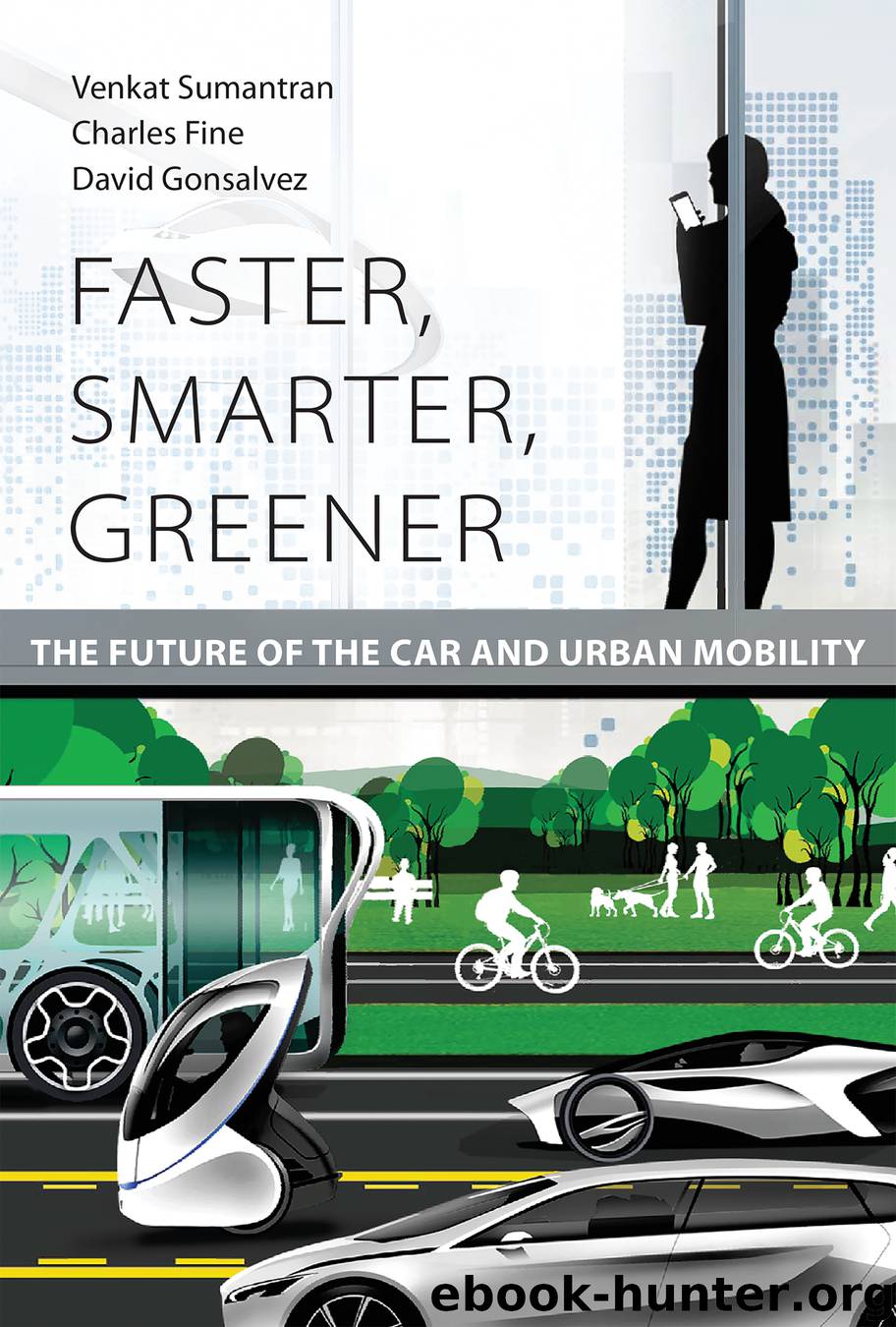Faster, Smarter, Greener by Venkat Sumantran

Author:Venkat Sumantran
Language: eng
Format: epub
Publisher: The MIT Press
Published: 2017-09-22T04:00:00+00:00
Figure 7.4 Vehicles and infrastructure communicating with each other will be a necessity in future mobility.
Source: U.S. NHTSA, U.S. Department of Transportation.
Figure 7.5 The era of cars communicating with other cars and with road and city infrastructure is expected to deliver a new level of functionality, safety, and efficiency.
Source: © Continental AG.
A second benefit could be fuel efficiency. Cars communicating with traffic signals can move smoothly through busy intersections and reduce the time spent and fuel wasted on idling. Every bicycle race demonstrates the principle behind platoons. Riders try to stay in the wake of the lead rider, so that the trailing rider experiences less wind resistance. So too, in tests on U.S. interstates in the state of Utah, with platoons of closely following trucks, the fuel efficiency of the trailing trucks improved by 4 to 10 percent.23 When this method is tried on a larger scale, even when the platoons involve no more than four or five trucks, the energy savings and carbon emission reduction over a full year can be substantial.
A third benefit that can be derived from the same connectivity technologies, particularly in a military context, is fewer drivers needed overall for a convoy of trucks. One driver might be used in the lead vehicle while the rest of the vehicles in the platoon follow the leader, in synchronized mode. In military applications, this change could limit the number of servicemen exposed to dangerous operations. Many believe that the use of semi-autonomous technologies will first see deployment in truck platoons for both commercial and military applications. The implication for cars is faster development of the core technology for the large car-using population.
In an effort to evaluate critical issues that stand in the way of deployment, in 2012, under a pilot evaluation program launched by the U.S. Department of Transportation, 2,800 vehicles were tested in a limited area around Ann Arbor, Michigan.24 As a part of the experiment, 73 miles of roadway were fitted with twenty-nine roadside equipment installations. These vehicles employed a combination of vehicle-to-vehicle and vehicle-to-infrastructure connectivity to monitor functional requirements and system performance. This large-scale effort, which also involved many U.S. and import automakers, as well as infrastructure electronics, has advanced understanding as to how such communication may function in real-world conditions in all seasons.
In 2016, the European Union launched the Truck Platooning Challenge. Six major commercial vehicle manufacturers, automakers, and their suppliers are engaged in research on such topics as the security of data communications, system integrity, and system robustness under varied environmental and traffic conditions.
As cars acquire additional capabilities, including direct communication with other cars and road infrastructure, even greater benefits to safety are anticipated. According to the U.S. Department of Transportation, such communication has the potential to help avoid 80 percent of accidents involving impaired drivers.
In closing
The manner in which global society has taken to smartphone connectivity hints at the value it places on this technology. Connected vehicles have a lot to offer to car users: they enhance productivity, safety, and overall user experience.
Download
This site does not store any files on its server. We only index and link to content provided by other sites. Please contact the content providers to delete copyright contents if any and email us, we'll remove relevant links or contents immediately.
| Automotive | Engineering |
| Transportation |
Whiskies Galore by Ian Buxton(41522)
Introduction to Aircraft Design (Cambridge Aerospace Series) by John P. Fielding(32881)
Small Unmanned Fixed-wing Aircraft Design by Andrew J. Keane Andras Sobester James P. Scanlan & András Sóbester & James P. Scanlan(32566)
Craft Beer for the Homebrewer by Michael Agnew(17925)
Turbulence by E. J. Noyes(7689)
The Complete Stick Figure Physics Tutorials by Allen Sarah(7134)
Kaplan MCAT General Chemistry Review by Kaplan(6582)
The Thirst by Nesbo Jo(6431)
Bad Blood by John Carreyrou(6268)
Modelling of Convective Heat and Mass Transfer in Rotating Flows by Igor V. Shevchuk(6218)
Learning SQL by Alan Beaulieu(6023)
Weapons of Math Destruction by Cathy O'Neil(5816)
Man-made Catastrophes and Risk Information Concealment by Dmitry Chernov & Didier Sornette(5638)
Digital Minimalism by Cal Newport;(5376)
Life 3.0: Being Human in the Age of Artificial Intelligence by Tegmark Max(5180)
iGen by Jean M. Twenge(5149)
Secrets of Antigravity Propulsion: Tesla, UFOs, and Classified Aerospace Technology by Ph.D. Paul A. Laviolette(4972)
Design of Trajectory Optimization Approach for Space Maneuver Vehicle Skip Entry Problems by Runqi Chai & Al Savvaris & Antonios Tsourdos & Senchun Chai(4837)
Electronic Devices & Circuits by Jacob Millman & Christos C. Halkias(4739)
